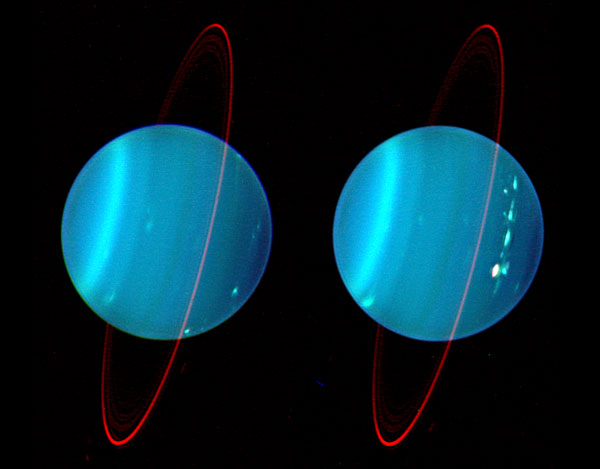Gallery

This figure provides examples of recent Uranus imaging with the Keck NIRC2 near-infrared camera on 11-12 July 2004 UT. These two images show opposite sides of the planet, with Uranus' north pole at 4 o'clock. Each color image is a composite in which near infrared images using J (1.26 micron), H (1.62 micron), and K' (2.1 micron) filters are assigned to blue, green, and red color components respectively. This roughly approximates the view that would be available to human vision if the response of the eye could be shifted to longer wavelengths beyond red (0.7 microns). Uranus' rings appear red in color because the K' image is boosted relative to the others to reveal atmospheric features that are strongly darkened by methane absorption in this band. The use of near IR wavelengths provides exceptional cloud contrast, which is enormously enhanced by the Keck AO system. The diameter of Uranus in these images is about 3.6 arc seconds, and the effective image resolution is probably near 0.06 arc seconds. When examined carefully, the left image reveals 13 cloud features and the right image displays over 18, for a total of 31 features in just two images. The bright white feature in the right hand image has exceptional brightness in the K' band, meaning it extends to relatively high altitude, and it strongly variable, as is the unusually large complex of clouds associated with it, both having changed dramatically by our next observing run in August 2004. The large complex, which extended over 80 degrees of longitude (30,000 km) , is probably the largest group of atmospheric features ever seen on Uranus. The isolated relatively bright green cloud near the lower left limb in the right hand image is the very long-lived feature that oscillates in latitude. The northern hemisphere of Uranus (on the right) is coming out of a long period of darkness and is not a mirror image of the southern hemisphere, indicating that there is some response to seasonal solar radiative forcing, even though little response was expected. The zonal wind speeds are asymmetric as well as the cloud morphology. The pictures reveal at more than 30 discrete cloud features, exceeding the total observed in all pictures obtained by Voyager, Hubble, and other telescopes up to the year 2000. Only eight cloud features were found in all the close-up images taken by the Voyager spacecraft that actually traveled to the planet.
Uranus is 19 times as far from the sun as the earth and thus receives about 360 times less solar energy. Even though Uranus is more than four times the diameter of the earth, it rotates more rapidly—its day is only 17.24 hours. Because its equator is tilted 83 degrees from its orbit plane it receives extreme seasonal variations in solar input, although the thermal time constant of Uranus is longer than its 84-year orbital period, so that little seasonal response is expected. The atmosphere of Uranus consists mostly of hydrogen, helium and methane. Methane is a condensable substance in the cold atmosphere of Uranus and bright cloud features are likely composed of methane ice.







